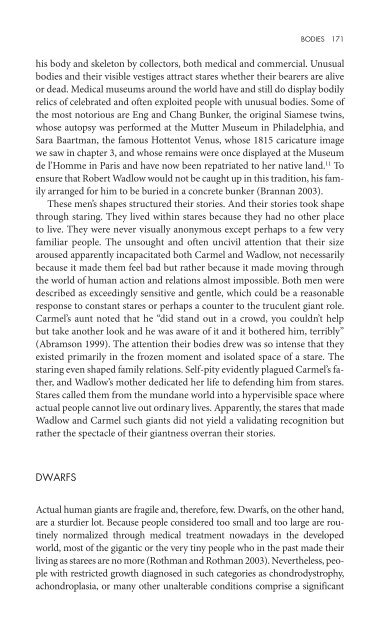Staring how we look sobre la mirada.pdf - artecolonial
Staring how we look sobre la mirada.pdf - artecolonial
Staring how we look sobre la mirada.pdf - artecolonial
Create successful ePaper yourself
Turn your PDF publications into a flip-book with our unique Google optimized e-Paper software.
LOOKING AWAY, STARING BACK 81<br />
through an outdoor market, the young Auld encountered a vision he was not<br />
“prepared for,” he told a New York Times reporter in 2006. He caught sight of<br />
a young girl who was significantly burned. Her face shocked him into staring,<br />
imprinting a vivid image that stayed with him over the years. “She was literally<br />
melted—no ears, no nose, just holes. Slits for eyes. Her neck was like a<br />
long, drawn thing.” His description captures his struggle to make sense of her<br />
strange face. So challenging was this task and so unprepared was Auld that he<br />
withdrew his stare, short-circuiting his inquiry into her humanity. When the<br />
girl <strong>look</strong>ed back at the man whose eyes <strong>we</strong>re locked on her face, he lost his<br />
voice and did “what everybody else did. I turned my head away” (Newman<br />
2006, 1.25). Haunted for years by this broken connection, Auld decided to<br />
address his regret with his art. He approached the Burn Center at St. Barnabas<br />
Medical Center in Livingston, New Jersey, in order to contact former patients<br />
to seek permission and cooperation in painting their portraits.<br />
“So go ahead and stare,” the open faces and direct <strong>look</strong>s in Auld’s portraits<br />
seem to say. In fact, one of the subjects, Alvaro L<strong>la</strong>nos, exp<strong>la</strong>ins his willingness<br />
to participate in the project by saying: “I’d rather people be staring at<br />
a painting than at me” (Newman 2006, 1.25). Another subject, Louise Benoit,<br />
appears in a double portrait along with her sister, Rebecca ( figure 7.1).<br />
Instead of the conventional double portrait of aristocratic couples or monarchs,<br />
<strong>how</strong>ever, this picture s<strong>how</strong>s sisters who acquired their distinctive<br />
<strong>look</strong>s together in a fire that killed five other family members. Auld means<br />
his pictures to sustain our stares, to give starers “the chance to gaze without<br />
voyeuristic guilt at the disfigured, [so] they may be more likely to accept<br />
them as fellow human beings, rather than as grotesques to be gawked at or<br />
turned away from.” In staring at the portrait of herself and her sister, Louise<br />
Benoit wonders <strong>how</strong>ever whether the arresting close-up views of their<br />
burned faces will disgust people or encourage them to “see more than scars”<br />
(Newman 2006, 1.25). What happens in the delicate transaction of <strong>look</strong>ing<br />
and <strong>look</strong>ing away is unpredictable.<br />
The artist Chris Rush also grants us “Permission to Stare” in his portrait<br />
series of “unusual children and adults,” most of whom are people with disabilities,<br />
that was exhibited at a Brooklyn gallery in 2006. 1 Rush’s drawings<br />
are studies from life done at a facility for disabled people where he volunteers.<br />
Like Auld’s paintings, Rush’s portraits gain their aesthetic punch by<br />
putting unusual faces in our faces. Whereas Auld uses bold texture and color<br />
to render scarred flesh less shocking but still compelling, Rush gets bet<strong>we</strong>en<br />
his subjects and our discomfort by softening their differences with the medium<br />
of conte crayon and posing them with great dignity. Rush’s pictures<br />
navigate bet<strong>we</strong>en us and them, attending carefully to the visual re<strong>la</strong>tionship<br />
by gratifying our “deep curiosity” while at the same time inviting “empathy”<br />
and “sensitivity.” The exhibition narrative exp<strong>la</strong>ins that the portraits invite


